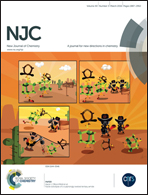Donor–acceptor type polymers containing the 2,3-bis(2-pyridyl)-5,8-dibromoquinoxaline acceptor and different thiophene donors: electrochemical, spectroelectrochemistry and electrochromic properties†
Abstract
Three donor–acceptor type π-conjugated polymers, poly[2,3-di(2-pyridyl)-5,8-bis(2-thienyl)quinoxaline] (PPTQ), poly[2,3-di(2-pyridyl)-5,8-bis(2-(3-butylthiophen))quinoxaline] (PPBTQ) and poly[2,3-di(2-pyridyl)-5,8-bis(2-(3,4-ethylenedioxythiophene))quinoxaline] (PETQ), containing the 2,3-di(2-pyridyl) quinoxaline moiety in the backbone as the acceptor unit and different thiophene derivatives as donor units were synthesized electrochemically. Characterization of the corresponding polymers was conducted by cyclic voltammetry (CV), UV-vis-NIR spectroscopy and scanning electron microscopy (SEM). Spectroelectrochemistry and electrochemical analyses demonstrated that all three polymers can undergo both p- and n-type doping processes. PPTQ exhibits purple red color in the reduced state, violet blue color in the neutral state, and gray blue color in the oxidation state. PPBTQ exhibits red color in the reduced state, light steel blue color in the neutral state, and dark slate blue color in the oxidation state. PPETQ exhibits green color in the reduced state, yellow color in the neutral state, and a colorless highly transmissive state in the oxidation state. PPETQ and PPBTQ revealed excellent optical contrasts of 80.3% and 78.2%, respectively, in the NIR region. The outstanding optical contrasts in the NIR region, high stability and fast switching times make these polymers excellent candidates for NIR device applications.


 Please wait while we load your content...
Please wait while we load your content...